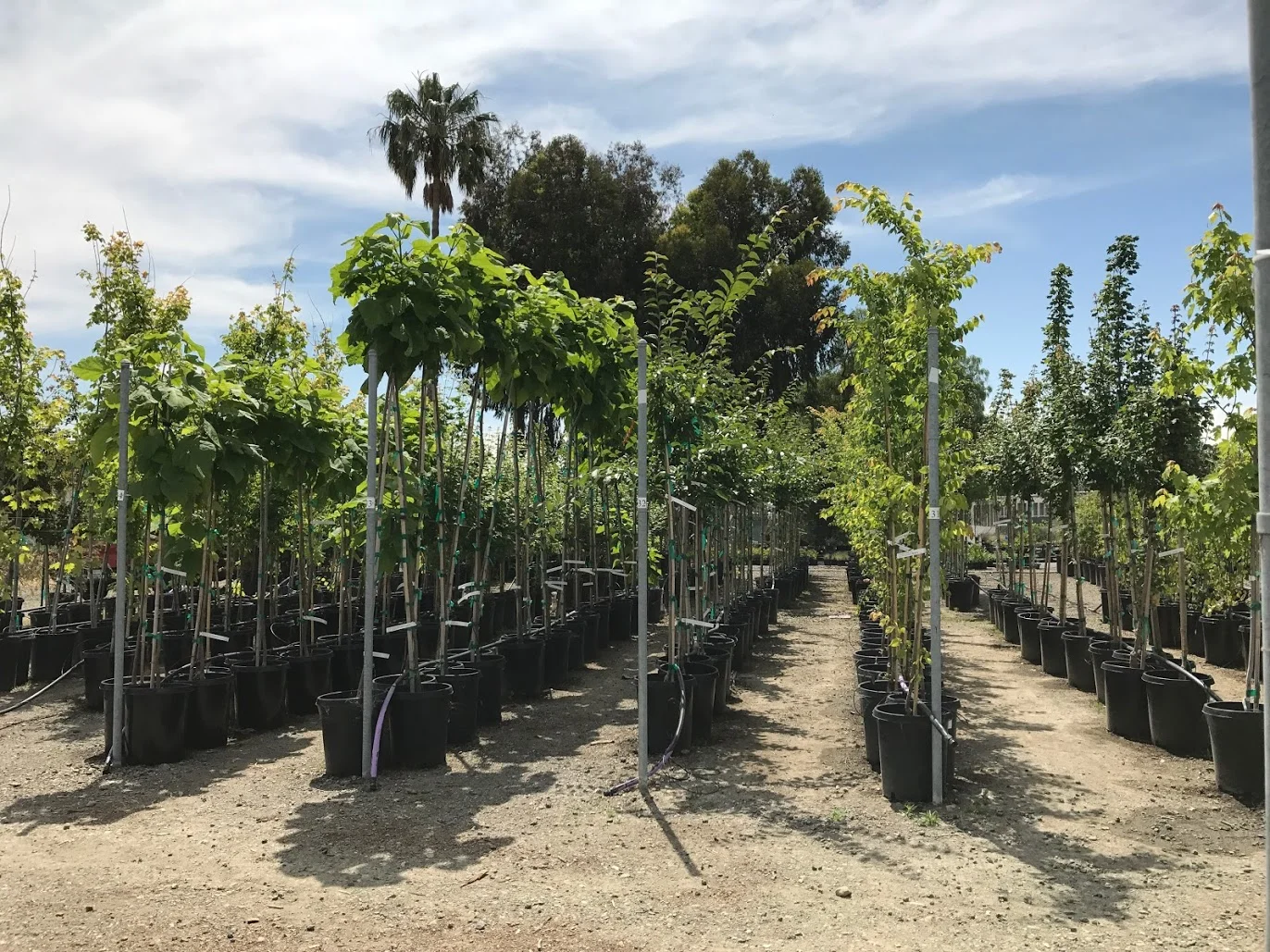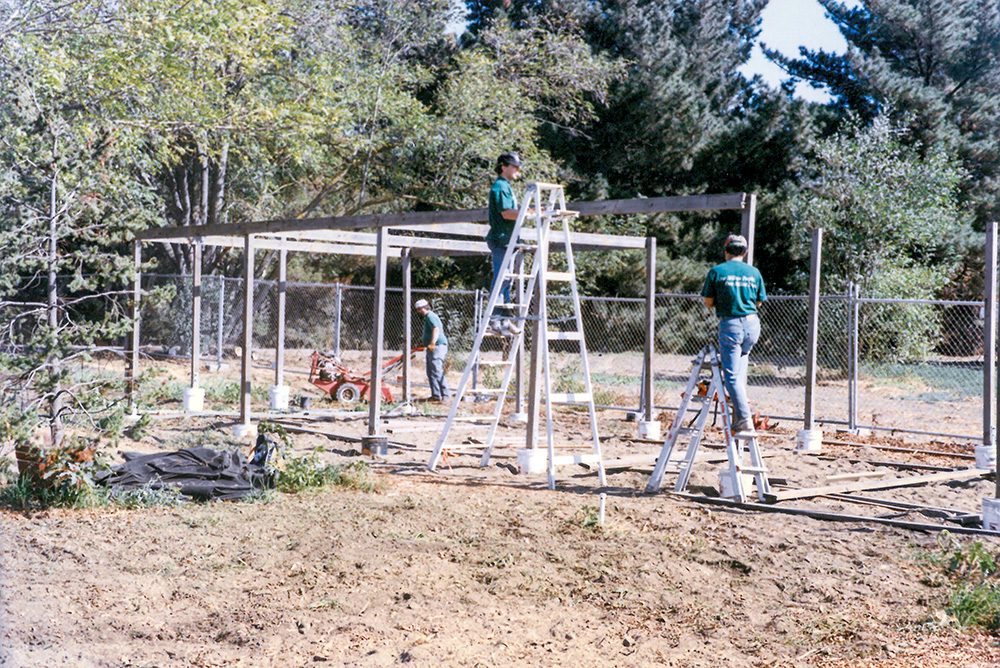Our City Forest’s Community Nursery and Training Center is situated on two acres near Mineta San Jose International Airport. It is home to some 2,350 young trees and 6,300 shrubs, nearly all of which were cultivated on site. The trees alone fill 38 rows spread across two large sections or ‘banks.’ In addition to its stock of plants, the Nursery keeps on hand sufficient planting materials and equipment to conduct regular community plantings of dozens of trees at a time. The Nursery also serves as a training site for AmeriCorps service members, Tree Amigos, tree stewards, and other community volunteers.
Our City Forest (OCF) has not always had a cultivation nursery to support its mission of greening Silicon Valley and engaging volunteers. The land that the Nursery leases today on Spring Street was made available by the City of San Jose in 2010, many years after CEO Rhonda Berry founded the nonprofit in 1994. A look at Our City Forest’s operation before it acquired the Nursery underscores just how valuable it is to OCF today. The Nursery enables OCF to control the supply, quality, and species of the trees and shrubs it wishes to plant, all while expanding its community of volunteers.
The beginning of the Watson Park Tree Bank shade structure.
Back in the day, OCF had to rely on wholesale nurseries in Sunol and the Central Valley for its trees. The wholesalers trucked the trees to an OCF “tree bank,” a storage yard for trees and supplies. They were located at a succession of sites in San Jose, first in Japantown then Watson and Kelly Parks. To get trees from the tree banks to the planting sites, OCF had to improvise. Rhonda estimates that OCF did not own trucks for the first 25,000 trees it planted. Instead, volunteers brought their own trucks to move trees, which resulted in headaches if their vehicles were dinged in the process. Volunteers also brought shovels and other necessary tools.
While the early plantings sometimes took unpredictable turns that had OCF flying by the seat of its pants, longtime Tree Amigo and Nursery Docent Judi Wilson remembers them fondly: “We had fun.”
The use of wholesalers and tree banks worked well enough that OCF was able to plant some 2,000 trees per year. However, the quality of trees received from the wholesalers was uneven and in many cases, some were unusable. As Staff Arborist Bo Firestone, who joined OCF in 2007, put it, “We would have trees delivered from a wholesale nursery perhaps the day before a project, and we might have to send half of them back. We then would be scrambling for last minute substitutions. Sometimes we wouldn’t even be able to plant all of the trees for a project because we had to reject some of them.”
The Watson Park Tree Bank shade structure.
The reasons for rejection varied. Trees arrived that were too small or too large for planting. Some were root bound or the roots were not developed sufficiently for planting. Some came with wounds or other damage, or structurally they were unsuitable. For example, some trees arrived topped, others lacked a strong central leader, and still others had been pruned into ‘lollipops’ - a popular conception of how mature trees should look that when imposed on young trees limits their access to photosynthates, the very thing that drives their growth.
Tree banks added another dimension of unpredictability. The availability of these sites was neither guaranteed nor always the best place to keep trees. For example, while using Watson Park to store trees, winter rains caused nearby Coyote Creek to flood. Christian Bonner, head arborist at the time, had the disquieting experience of watching the flood waters carry 6,000 donated tree seedlings downstream. Later, in 2005, OCF was forced to vacate the park when lead and other toxins from an old municipal dump were found in its topsoil, a discovery that closed the park for almost six years while it was cleaned. A 10 month delay in receiving approval for a new site from the City of San Jose limited OCF’s ability to plant trees. Volunteers were not allowed in the tree bank, and OCF, without AmeriCorps members in its early years, had only its staff available for plantings.
After the closure of Watson Park, OCF moved its tree bank to Kelly Park, a site that was large enough to accommodate both a shade house (built by Tree Amigos) and a limited amount of cultivation along with the usual stores of trees and equipment. As much as OCF members appreciated the charm of the park and the opportunity to grow plants, it would be OCF’s final tree bank. Bigger opportunities were in store for OCF, namely the chance to finally plant trees on privately owned, residential properties--a development that hitherto had been denied OCF and one with vast, untapped possibilities. It made a cultivating nursery, i.e., a place to grow the trees needed for residential planting, a necessity.
The Kelly Park Tree Bank.
For the first 15 years of its existence, Our City Forest relied on grants that stipulated OCF could plant only on public lands, such as parks and schools, or along streets. However, in 2007, the City of San Jose passed its Green Vision initiative that among other actions called for planting 100,000 trees by 2022, including on private property.
The OCF Team at the Kelly Park Tree Bank in 2008.
Rhonda Berry approached the City about its expansion of urban forestry goals, knowing the largest untapped planting area was within private yards. OCF and the City reaffirmed their partnership in greening San Jose through jointly leveraged resources, knowing that more varieties of trees were needed--and not to mention simply more trees! From this confluence of events and political support came the beginnings of Our City Forest’s Community Nursery, but much more funding and support would be required, and from outside San Jose.






